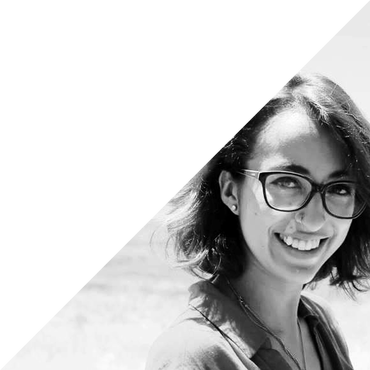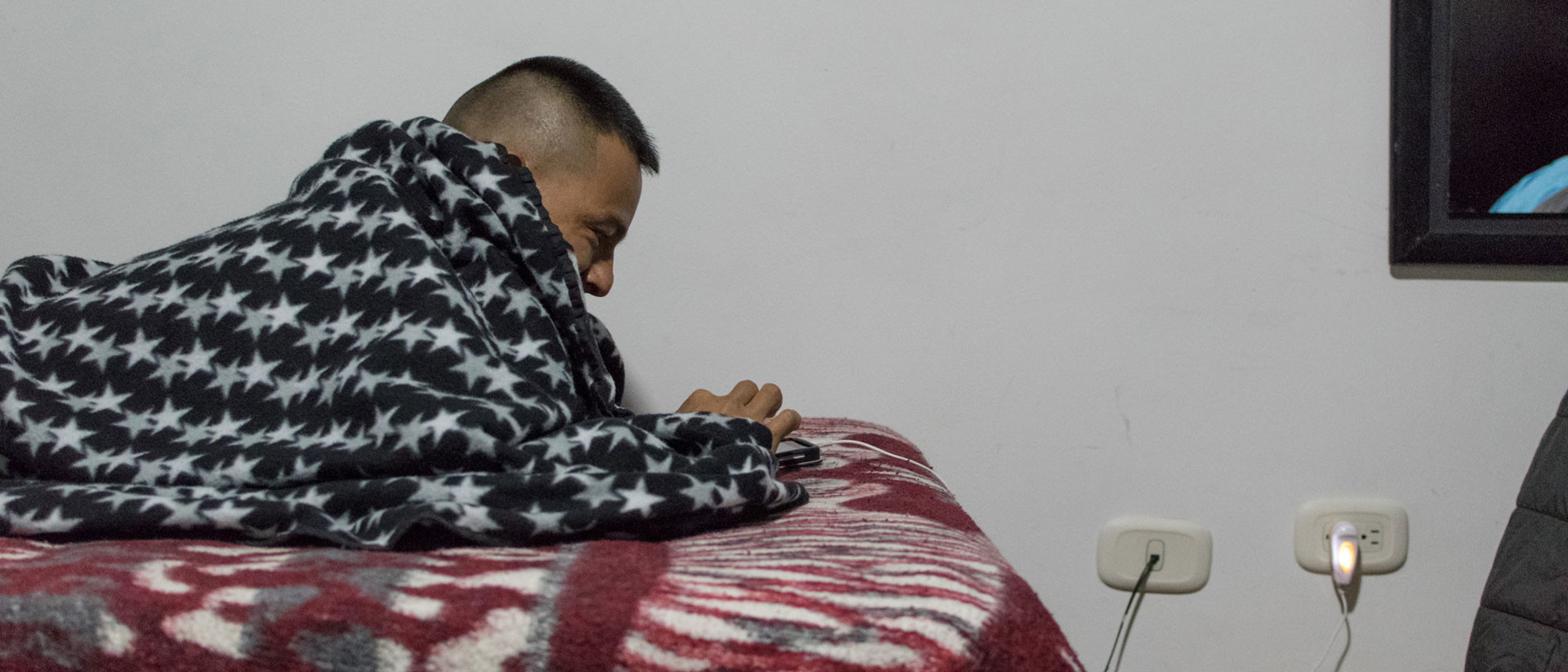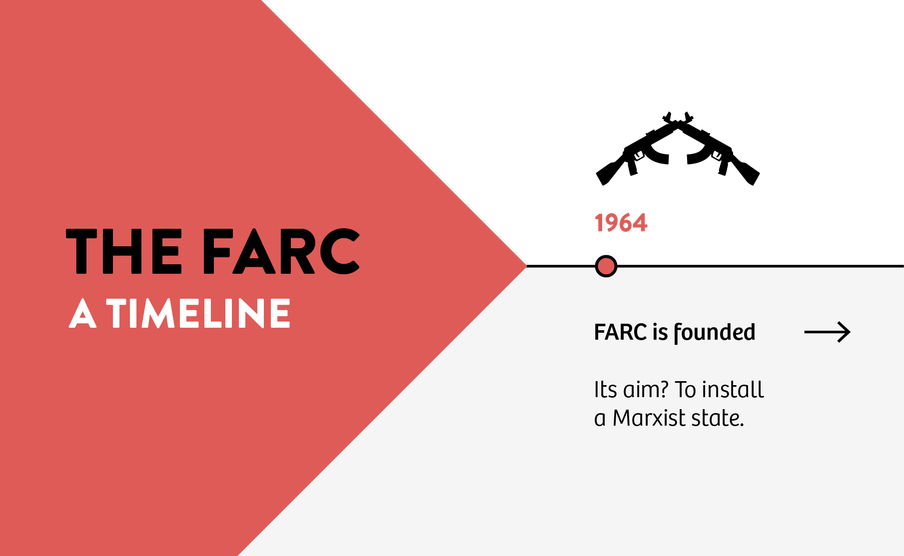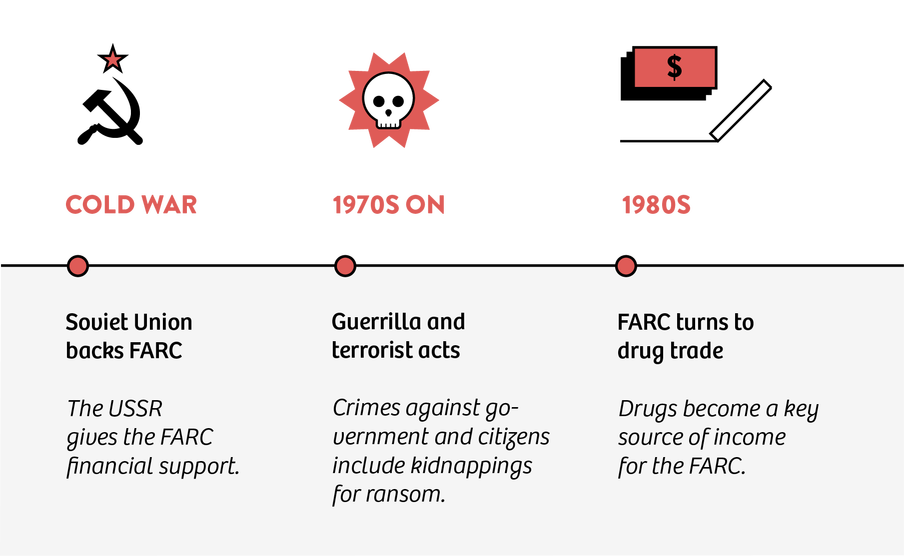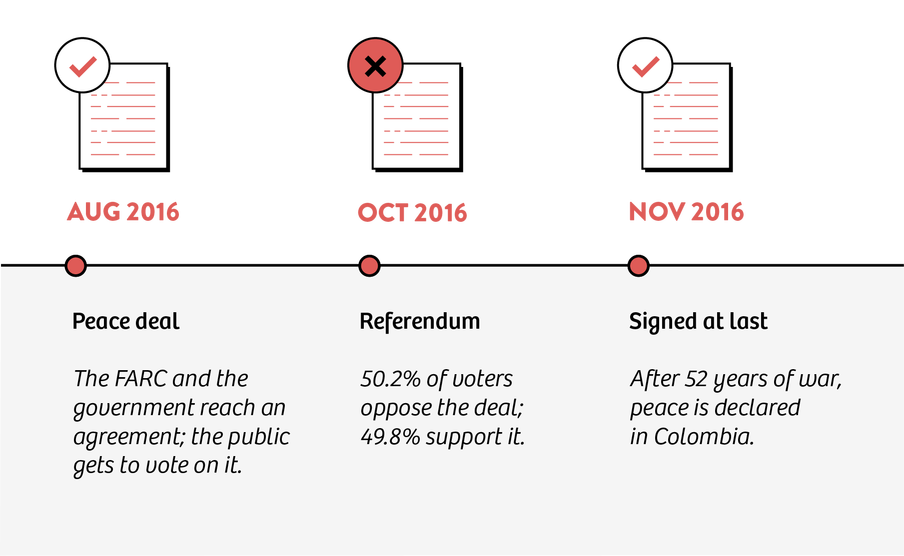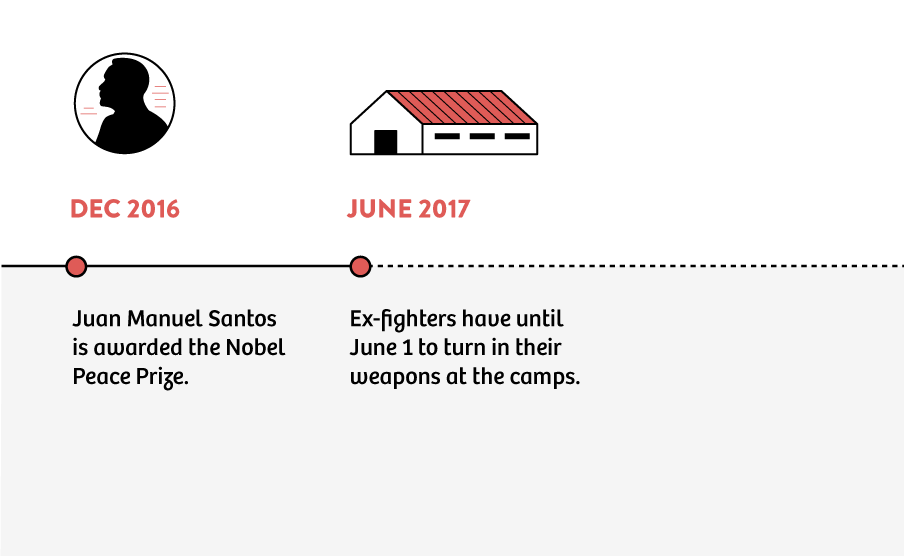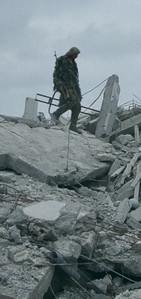Marcela Moreno was born in Bogotá, the Colombian capital. In her teens, she left the city for the interior, to join the FARC’s rebel army.
But on August 26, 2016, the guerrilla movement signed a peace agreement with the Colombian government. Moreno had been in prison for months by then, but the government pardoned her. So the 37-year-old returned to city life.
After living as a fighter for so long, she didn’t find it easy.
Today, Moreno heads a foundation that clears land mines – the most dangerous legacy of a conflict that raged for more than half a century.
“There’s no feeling of connection with other people here,” she tells me when we meet in Bogotá. “I don’t know how people can make decisions or society can develop if people don’t feel involved, whatever their political party or preference. All people care about is keeping the front door closed.”
How do you go back to ‘normal’ life?
The deal Moreno received as part of the peace agreement was also offered to other former FARC fighters whose only offenses were political ones. She’s now trying to reintegrate into civilian society and to live alongside people who saw her as the enemy.
It’s uncertain how the Colombian peace process will unfold in the years to come. Either way, there’s apathy and resistance among the population. The most obvious step – and the hardest – is for ordinary Colombians to embark on a dialogue with their former enemies. But the effects of longtime division are still palpable. And whatever else happens, allowing violence to erupt again isn’t an option.
To speak of reintegration in Colombia, then, is to walk on eggshells. The situation is still shaky and fragile. I wanted to find out what rejoining society meant for these ex-fighters. So I spoke with a few in disarmament camps, and a few others who’d been pardoned.
It wasn’t easy. Since they don’t like talking to the press, making contact is no simple matter. And when FARC fighters talk to journalists, their old enemies get suspicious.
In the interviews, I asked questions submitted by Correspondent members in response to an appeal I posted. Here’s a sample:
- What challenges do ex-fighters face in reintegrating?
- How can they restore the public’s trust?
- Do they still feel at home in Colombia?
- Are they listened to?
As a journalist, I’ve been reporting on the victims of the war in Colombia. But I’d never had the chance to spend hours talking to ex-fighters before. And their stories don’t make it into the mainstream media.
Despite their initial skepticism, they were ultimately willing to share their stories at this crucial juncture in Colombian history, and it was remarkable to hear them.
Income and a pension for every ex-fighter
Marcela Moreno is one of 177 ex-fighters pardoned so far. That’s the group I focus on in this story. These people have bypassed the disarmament camps and begun the reintegration process in the capital, Bogotá.
It’s expected that 3,700 political prisoners like Moreno will eventually be freed – people who haven’t committed serious crimes but lesser political offenses.
Conditions for their reintegration were drawn up as part of last year’s peace deal. Provisions include income, social security, pensions, housing, access to education, psychological support, and the validation of skills acquired during their time in the FARC, such as reading and writing.
In practice, the reentry process will begin only once all the ex-fighters in the so-called transition zones have relinquished their arms. The original deadline was June 1, 2017, but has now been extended by 30 days.
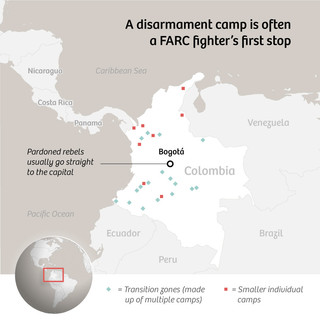
Priority number one: medical care
Meanwhile, some ex-FARC fighters have already begun the return to normal life. Most are in Bogotá, living with fellow ex-guerrillas in hotels they call “shelters.” It’s here that the FARC’s first legal organization, FUCEPAZ, was founded, for the purpose of promoting reintegration.
Over the past year, FUCEPAZ has set up a program with Colombia’s open university for distance learning, Universidad Abierta y a Distancia (UNAD), to help ex-fighters obtain elementary or secondary schooling on a flexible timetable. This, in turn, will help them get jobs.
Colombia’s National Reincorporation Council, made up of two representatives from government and two from the FARC, is in charge of reintegration policy.
The Colombian Agency for Reintegration, meanwhile, oversees the ex-fighters’ first steps back into society. Priority number one is getting them medical care.
“We saw a lot of people in poor health. In the worst cases, limbs had to be amputated”
“Most ex-fighters were arrested mid-battle,” says psychologist Andrés Ponce, who’s supervising the process. “In prison, people are crammed together, so the place is crawling with bacteria, and there’s neglect. We’ve seen a lot of people in very poor health. In the worst cases, limbs even had to be amputated.”
Part of the former rebels’ return and adjustment to their new lives is learning to deal with Colombian bureaucracy. Like most of their fellow citizens, they have to wait to see doctors, obtain ID cards, and open bank accounts.
“They complained about how long everything took,” Ponce says. “When they were FARC fighters, there was always plenty of everything, and procedures always happened quickly.”
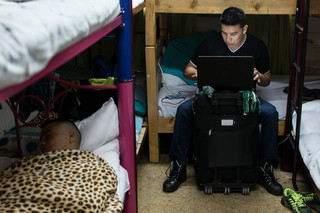
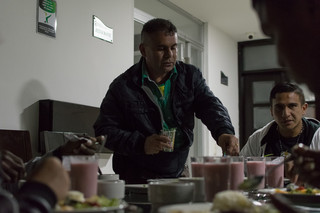


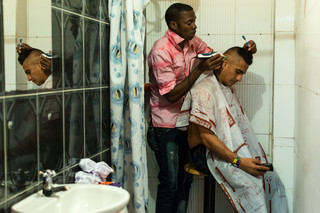
Everyday life in Bogotá, in one of the hotels where ex-guerrillas live together and work toward reintegration. Photos by Gabriel Corredor for De Correspondent
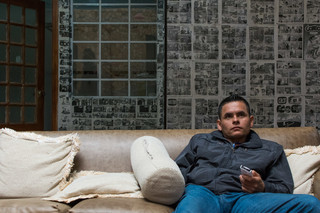
What about the victims?
Blanca Yoli Real was driven from her home by violence three times.
The first was in 1998, when a death squad of 200 paramilitaries wreaked havoc in her village of Caño Jabón. A few months later, a threat from a FARC front forced her, her husband, and their four children to leave again. Staying wasn’t an option; they’d have become military targets.
And in 2004, with the FARC aiming to recruit her eldest son, Real fled the village of Caño Negro.
Today she heads an association for female victims in Vichada, a disregarded but large department in the east of the country.
Real never got to know Marcela Moreno, but she came face to face with fighters and commandants in the areas she fled. She crossed three Colombian departments to survive the war.
Now the truth must be brought to light, she says. “Many victims hope to find out what happened to their children. People want to be able to grieve, so they can reconcile with those who drove them from their homes, murdered a member of their family, or kidnapped someone. Everybody makes mistakes in life, but I think we have to be able to forgive.”
Colombia’s guerrilla war created countless victims of crimes including kidnapping, robbery, attacks, forced recruitment, and land mines. The war killed 220,000 people. And 81% of casualties between 1958 and 2012 were civilians.
Fighters turned witnesses
Moreno prefers not to say exactly how long she was in the FARC but says she spent time in departments including Meta, Caquetá, and Cundinamarca. What does she think of the harm done to civilians? “Sometimes war forces you to take certain extreme positions,” she says. “The conflict took us to a point where there was no room for nuance. We’re aware that that can’t be allowed to happen again.”
The law covering amnesty for FARC-related political offenses has its opponents. Critics of the peace process say ex-fighters are getting off too lightly. But the law decrees that pardons won’t be granted to perpetrators of rape, torture, or extrajudicial executions – in other words, crimes against humanity.
And once they come out of the camps, FARC fighters are required to cooperate as witnesses of these crimes before special tribunals – sometimes in exchange for a reduced sentence. And justice often clashes with the search for truth, not only in Colombia but in every peace process.
The difficulty of communicating
The group home where Marcela lives employs a receptionist, a bookkeeper, and two police officers who guard the entrance. At first, they and the ex-fighters didn’t speak to each other. Once they finally started to communicate, the employees brought up kidnappings, attacks, and recruitments. Sometimes, the former FARC rebels explained why they’d joined the movement. Such conversations recur whenever they meet someone new. The lack of trust is a barrier the ex-fighters would like to eliminate.
“A lot of people don’t like us much; they think we’re monsters,” says Ever Verbel, a member of FUCEPAZ who joined the FARC at 18. He comes from the department of Antioquia, in northwestern Colombia. Verbel says the media never mentions the good things the FARC’s done. Rebels ran schools in isolated villages, for instance, though the rest of the country saw it as a recruitment method.
“A lot of people don’t like us; they think we’re monsters”
Does Verbel still feel at home in Colombia? “I’ve always felt at home,” he says. He sounds calm, not at all nervous, but adds, “It took us a lot of effort to make a place for ourselves in this city after leaving prison.”
To regain trust and redress some of the harm done by the war, FARC members, with the government, started Humanicemos DH, an organization that clears land mines. Marcela Moreno serves as its director. As a condition of the peace agreement, 1,200 to 1,500 former FARC fighters will clean up explosives.
The FARC used mines as a strategy to keep control of regions and villages. Mines posed a constant threat to people in the countryside. From 1990 through March 2017, 11,481 land mine victims were recorded.
“Clearing mines makes it safe again, so people can come back to this land,” Moreno says. “There are still areas where no crops are grown, because they’re known as places where there are likely to be explosives.”

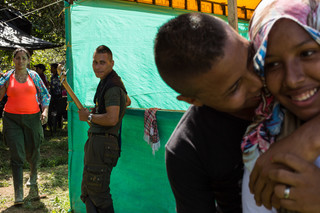
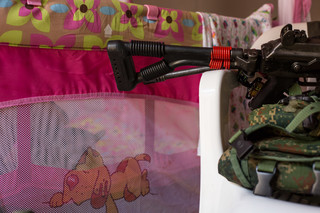
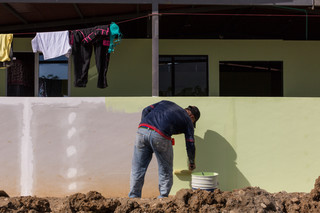
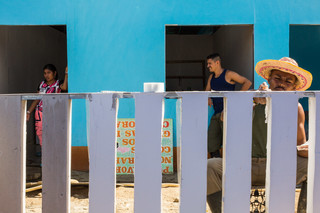

Former fighters live together in transition zones, where they surrender their weapons and begin to reintegrate. Photos by Gabriel Corredor for De Correspondent
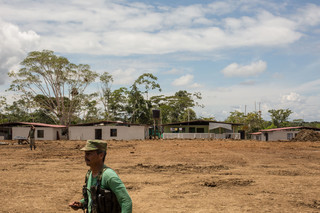
The threat of new violence
“Today we’re here, but tomorrow they could kill us,” Sandra Isaza says in a worried voice. A legal representative for FUCEPAZ, the FARC reintegration organization, the 39-year-old was one of the first ex-fighters to be pardoned. She took part in the peace negotiations in Havana last year. She also went to prisons to inform inmates about the accord – “promoting peace,” she calls it. Isaza says she has faith in the peace process but worries about how the government is implementing it, especially when it comes to protecting former guerrillas.
Some pardoned fighters don’t want to go home for fear of endangering their families. In April, their worries were fueled by the assassination of Luis Alberto Ortiz, a pardoned ex-guerrilla who was visiting his family in the port city of Tumaco.
Some organizations say the paramilitaries are gaining ground, though the government doesn’t acknowledge it. They rushed to fill the vacuum left by the FARC and now see it and local and activist leaders as their new enemies. Between January 1, 2016, and March 5, 2017, 156 such key figures were assassinated.
“Personally, I think society should give us a chance,” Isaza says. “But we shouldn’t pray, beg or plead for it. No. Because I don’t think many guerrilla fighters regret their actions. We are self-critical about mistakes made within the organization. We’re human. Maybe there are some things that should never have happened.”
More than a listening ear, she seeks a speaking mouth: she hopes to bury the hatchet through dialogue with her former adversaries. “This process shouldn’t be allowed to fail,” she says. “I think we’ve put a lot into it. And I think there’ve been enough murders and disappearances.”
To keep people on the straight and narrow, the government has promised to investigate paramilitarism, to work to prevent a fresh outbreak, and to dismantle the new criminal organizations.
If a threat to peace is identified, the state will take swift legal action.
The job now: engaging ex-fighters
“If we don’t provide programs former guerrillas can get involved with and they don’t have new goals to get behind, I think things could easily go wrong again,” Isaza says. “We’ve always believed you can work to create peace. But it’s the state’s duty to watch over people living together, to look after security and the needs of the population.”
To be released from prison, Isaza, like every pardoned rebel, had to promise to eschew weapons. According to Colombia’s Office of the High Commissioner for Peace, recidivism is the worst possible scenario. It would mean the pardoned would forfeit all the privileges of freedom.
Asked for more information on the matter, the agency said it is “expected of those who have been pardoned that they will participate in the reintegration process to become law-abiding citizens again. In this way, they can work toward returning to society and become people who can take part in building a better country.”
Space for suffering on both sides
The United Nations argues that security and access to dignified living conditions for demobilized fighters are fundamental requirements for peace. “The opportune establishment and effective functioning of security and protection mechanisms for them [those who have been pardoned – LV], and the creation of employment contributing to social infrastructure, can strengthen reintegration,” it said in a report.
But FUCEPAZ’s Sandra Isaza – like Blanca Real, who represents victims in Vichada – says there needs to be room to express suffering too. “We’ve worked very hard to listen well, with respect and as tactfully as possible, because this is about people’s vulnerability and pain,” she says. She hopes, however, that there will also be space to find out more about murdered fighters, something that was forbidden during the war.
“I’m not trying to justify anything, but we have a lot of painful memories too,” she says. “Civilians talk about their children, brothers and sisters who died. But I’ve never heard a guerrillero’s mother say, ‘They told me my son died in that ambush.’ And I wish I could.”
This article was written for De Correspondent. It was translated from Spanish to Dutch by Fennie Steenhuis. English translation by Laura Martz.



